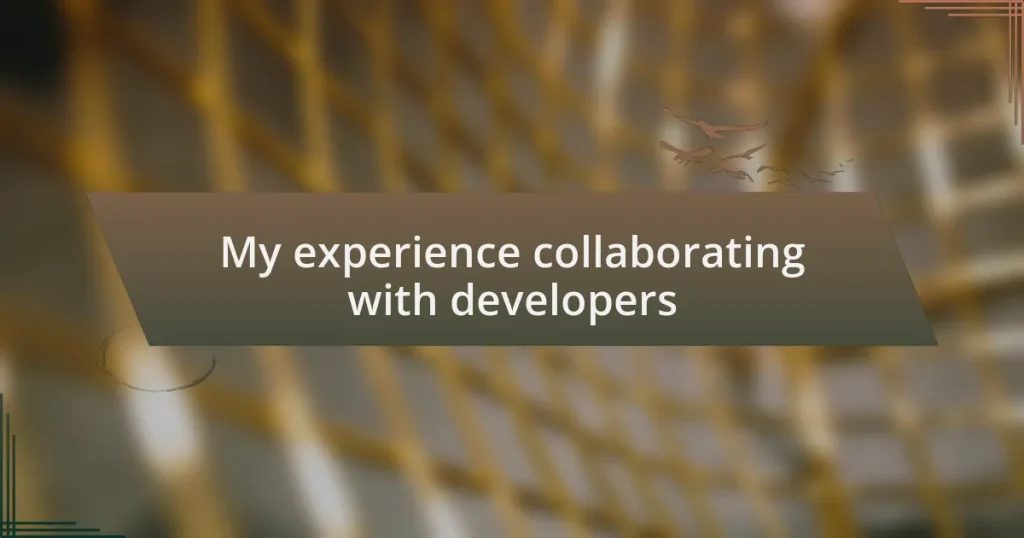Key takeaways:
- Collaboration between designers and developers enhances creativity and leads to successful web design.
- Clear communication and setting common goals are essential to overcome challenges in teamwork.
- Embracing constructive criticism helps improve designs and fosters a positive collaborative environment.
- Recognizing and celebrating small wins boosts team morale and reinforces a sense of unity.
Understanding web design services
Web design services encompass a wide array of elements, from creating visually appealing layouts to ensuring user-friendly navigation. I remember a specific project where the initial layout felt uninspired. It was through collaboration with developers that we transformed a basic structure into something vibrant and functional, illustrating how crucial teamwork is in this process.
When I first delved into web design, I underestimated the importance of responsive design—how a website feels on different devices. There was a moment during a project where feedback from clients highlighted navigation issues on mobile devices. This revelation was pivotal; it sparked conversations with developers about adaptive techniques, and suddenly, I understood that successful web design isn’t just about aesthetics—it’s about accessibility and user experience.
Have you ever visited a website that felt cluttered or confusing? I certainly have. Those experiences motivate me to prioritize clarity and simplicity in my designs. I’ve found that collaborating closely with developers helps in crafting a seamless user journey, where every click feels intuitive. This insight has reshaped my approach, allowing me to view web design through the lens of the end user’s experience.
My initial thoughts on collaboration
My initial thoughts on collaboration began with a realization of its impact on creativity. In one of my first projects, I was hesitant to share my ideas with developers, worried that they’d overshadow my design vision. But when I finally opened up, I discovered that their insights brought my concepts to life in ways I hadn’t imagined. This experience taught me that collaboration is not about compromising your vision; it’s about enhancing it through shared expertise.
As I navigated different projects, I found that effective collaboration often stems from trust. I recall working late one night with a developer who was just as passionate about the project as I was. We bounced ideas off each other, and I felt a rush of excitement watching our thoughts intertwine into a cohesive design. It was in those moments that I learned collaboration can spark innovation—when you blend diverse perspectives, you unlock creative potential that might remain dormant in isolation.
Have you ever experienced that ‘aha’ moment when a team member’s input completely shifts your understanding of a project? I certainly have. Each collaboration has pushed me to think more critically and expand my design approach, reinforcing the idea that every voice matters. It’s a reminder that in the world of web design, collaboration isn’t just beneficial; it’s essential for crafting successful and impactful websites.
Challenges faced while collaborating
Working side by side with developers, I’ve encountered several challenges that really tested our collaboration. One major hurdle was miscommunication; I remember a specific project where I made an assumption about the technical capabilities of a tool we were planning to use. This oversight led to significant delays, and I felt the weight of responsibility for not clarifying things upfront. Have you ever tried to explain a design concept only to realize your technical partner is on a completely different page? It can be frustrating, but it’s a learning moment that reinforces the need for clear dialogue.
On another occasion, differing priorities created a strain in our workflow. Developers often operate under strict timelines, while I tend to focus on fine-tuning design elements even when the deadline is looming. I found myself torn between pushing for perfection and understanding the urgency of the launch. Balancing these conflicting mindsets was challenging and made me appreciate the importance of aligning our goals early in the process. Has this happened to you too, where the urgency of one aspect clashed with the creativity of another?
Finally, I can’t overlook the challenge of differing feedback styles. In one instance, a developer provided blunt critiques of my design work, which initially stung. I had to remind myself that their objective was to strengthen the project, not to attack my vision. This experience taught me to embrace constructive criticism, shifting my perspective to view feedback as a collaborative tool rather than a personal affront. It’s a delicate dance, don’t you think? Navigating these challenges ultimately made our collaborative efforts stronger and more meaningful.
Successful strategies for effective teamwork
To foster effective teamwork, I’ve learned that establishing clear communication channels from the start is crucial. On one project, we decided to use a shared project management tool that allowed everyone to track progress in real-time. This transparency not only kept us accountable but also fostered a sense of camaraderie. Have you ever felt the satisfaction of seeing your team collectively moving towards a goal? It truly motivates you to keep pushing forward.
Another strategy that has proven invaluable is setting regular check-in meetings. I’ve found that informal catch-ups, even for just 15 minutes, can significantly prevent misunderstandings before they escalate. For example, during a recent project, I suggested a bi-weekly sync to address any design or technical concerns proactively. This small change facilitated a quicker resolution of issues, allowing us to maintain momentum. Do you think an open-door policy could reshape team dynamics for the better?
Lastly, celebrating small wins can significantly boost team morale. I remember the excitement in our virtual meeting when we completed a challenging milestone ahead of schedule. Taking a moment to acknowledge our efforts transformed a stressful atmosphere into one of shared . Don’t you think recognizing achievements, no matter how small, reinforces teamwork and encourages everyone to strive for more? It’s these little moments that can turn a group of individuals into a cohesive unit.
